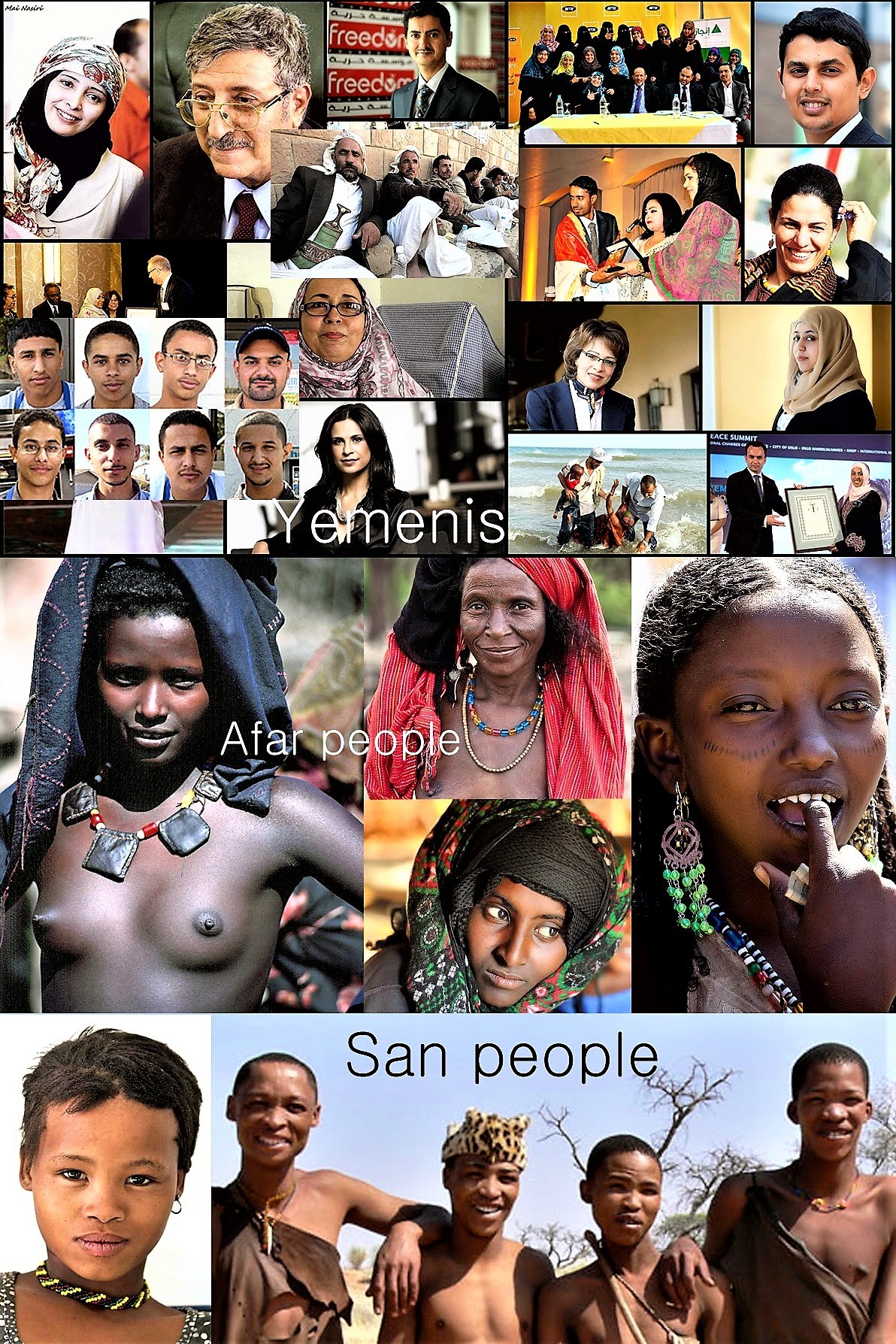ʼ(ʾ) This letter is IPA for Hamza, a very short ‘a’, as in “about”. It is the first letter of Adam.
‛(ʿ) This letter is IPA for ayain, a strong letter and probably the origin of Enlgish add, the equivalent of which in Arabic is ‛ad (عد).
Sometimes between 10,000 and 40,000 years ago or more, a group of people crossed the southern end of the Red Sea into southern Arabia for reasons that may have included a drastic change in the climate that diminished water and food resources, tribal conflicts, fear or a combination of these and probably other unknown reasons.Etymologically, there exists to this day in south west Arabia an area that bears the name of the group Eden but it is pronounced ‛Dn, either after the group’s name, the founder’s name or both. This is plausible for a number of reasons including the fact that Ad, the greatest father of humanity, is both the name of the founder and his tribe.
Eden is part of *YMn, the ancient name of Yemen. It is a suffixed extension of the ancient root *YM (*YM+n= Yemen). This root appears to be a secondary root, meaning it was derived from a previously invented root *MY. The ‘y’ in the name is a vowel, and like many other vowels it may change at the beginning of a certain word, or subject to its position either in the middle of the word or at the end.
On inspection and comparison *MY appears to be a variation of *Mʼ “water”. *MY and *YM are the two joint linguistic foundations of a linguistic cluster that comprises a number of extensions derived from each root with a root average of about 10 extensions. Each root is a category on its own grouping triliteral extensions that express things, aspects or concepts of a certain field or domain known to our ancient ancestors and sufficiently important to warrant a special unique root, such as “water” which probably belongs to the first generation of invented roots (Note the root *AM /*YM in Akkadian tiāmtu: [Humanities → Geography] sea, lake).
Once the etymologist identifies the category, he or she can begin analysing a stock of words that may appear to be extensions of both the primary and the secondary roots. The primary root is the root invented by the speakers of the language first. Think of it as a page. On this page a number of meanings are assigned by the people to the primary root. With the passage of time, the list of words becomes long and may cause confusion. New eras and activities produce their own things and concepts that need to be expressed. The people turned over the page of the primary root and began filling the back page with names of additional things and concepts they needed to express and use in communication.
We are not exactly certain, but it looks the invention of secondary roots may have been dictated by emerging awareness. Things and concepts were seen and contemplated by a human being who realised that he or she exists in a describable state and identified position here, in this place, at this time. This awareness was expressed in the root I. However “I” had to be defined in both current time and current place.

There was no need to invent two new roots to express “here” and “now”. If “I” exists he/she exists because he/she is “here” and he/she is “now”. The root *ʼN (*AN) was given the three meanings: _I, here, now_. In modern Arabic *ʼN is conceived as a conditional article like “if”. The implication is that if the three concepts of person, place and time are not jointly realised the absence of one will cancel the other two. In simple terms if “now” doesn’t exist neither “here” nor “I” exist.
The reason why un in French means “one” and in in English means “here” and “ta” in ancient Arabic means “two” expressed in English and French as “two” and “deux” can be explored by those who wish to do so but may want to add to them “three” and “trois” along with their origins. The reason is that in ancient Arabian ‘tar’ meant “a great deal” and “earth” because it is plentiful. The same is found in modern Arabic with an ‘th’ substitution ‘thar’ “rich”. This letter is not an ancient Arabian letter and may have been introduced by Jews or Phoenicians.
*Mʼ “water” is the primary root because it expresses a source essential for life. The root *ʼM, means “mum”, because she provides the water for her home and children and the other vital liquid for babies “Milk”. While each root is a category, both roots are a much bigger category. *Mʼ and *YM mean “water”. Yemen is the name of the country and the name of the sea. The sea contains the land of Yemen so Yemen is part of the sea. This may look simplistic but it took us almost two years to realise that the failure to identify the association between primary and secondary roots was caused by thinking of the ancient past in terms of the recent past or the present. To understand the language of prehistoric man one must try to think like prehistoric man and view the world in the simplest way possible. Not in all cases, but common is the saying, “If it’s not simple probably it is not ancient.”
A surprising number of words beginning with a hamza ( ʿ(‛) ) were found with “ayin” (‛/ʿ) including *ʼL and *‛L both of which mean “God”, or *IL, EL, Eli and Allah, and *ʻD (Ad or Adad)/ *ʻD (or ʻ(ʿ)Ād and the people ʻDites or Aʻadites, i.e. Yemenis).The two tribes were different but not alien. It is possible the tribe of ‛D adopted the name of ʼD but changed the first letter.
A guess is that the tribe of Ad was living in the eastern part of the southern Arabia and became acquainted with the tribe of A’ad in later times. Fear of ferocious unidentified monsters may have driven the clan of Ad to seek shelter in the western part close to the clan of Aʻad.
The two clans were united in one nation. Their language, “Ancient Arabian” or “Ariba” but known in the commonstream as “proto-Semitic”, survives in its united form in Akkadian, Arabic and other Ancient Arabian linguistic daughters. The tongue is made of the two different linguistic origins each with its specific characteristics that can be identified by two initially different constructions of roots and certain letters of their alphabet including the hard ‘g’ and ‘p’.
If archaeologists are right in dating the foundation of the city of Eridu ca. 5400 BC, it may be assumed that 7,400 years ago a conflict between the leaders of the nation that changed the history of the world more than any other erupted. Ad appears to have killed A’ad who commanded a formidable faction of the one nation, known also as Yemenis. The followers of the murdered leader were shocked and prepared to avenge him.
Some of the people of Ad may have thought their leader was at fault. Their leader, however, had no other choice but to flee along with a number of his closest relatives and supporters. They headed east to their original homeland which was maintained throughout by those who were left behind following the unification of the two tribes by Tai, one of Ad’s five sons that dominated parts of ancient history.
The successor of the murdered Aʻad marched east at the head of a large army. Ad and his son Tai prepared as much as they could but their followers were almost annihilated in a battle that seems to have taken place in the eastern part of today’s Sultanate of Oman. Assisted by seafaring people of a different race (probably ancient Sumerians), Ad managed to escape with some of his remaining followers taking refuge nor far from the location of today’s Basra city in southern Iraq. His son Tai appears to have managed to flee as well.
The A’adites were not seafarers so Ad and his followers and allies were safe in southern Mesopotamia but not for long. A’adite armies marched to southern Iraq and forced Ad to flee north where he seems to have founded the city of Akad (Akkad) which became in later times a small empire. This was the A’adites next target. They took the city and established their own kingdom which grew into a bigger empire under Sargon, a name that belongs to a famous linguistic structure, nucleitic compound, made of two different roots *ŠR and *KN. the second is a Yemeni root, a secondary of the primary *NK “fuck”. The Adites have their own category root *’R which has a large number of meanings including “fuck”.
Linguists of Semitic languages who wondered why Proto-Semitic has some double identical roots or words may have found the answer. Proto-Semitic was a unified language combining the tongues of the two tribes. The initial roots of Adites are bilaterals. Those of the Aʻadites are mostly mono syllabic root morphemes or “paired” letters, many of which are human vocalisations of sounds made by cats, hyenas, serpents and birds.
PHYSICAL CHARACERTISTICS OF THE AʻADITES
Adites and Aʻadites belonged to two different tribes but they are one race. This should be obvious since all modern humans, you and I and everybody else, have a common biological or genetic source. Studies and literature on the “out of Africa” are countless. Observed by a writer is that “DNA comparisons of samples all over the world, specific enough information has been analyzed to narrow down information on genetic origins to an original community of 10,000 or fewer individuals. These details and procedures are detailed in works by the specialists in that area. This sequence of migration from Africa to other parts of the world is indicated by genetics and corroborated by archaeology, linguistics and other disciplines of study” (Dr. Orville Boyd Jenkins,
http://orvillejenkins.com/ethnicity/geneticsoutofafrica.html).
Nothing like “pure blood” exists anywhere and probably never did a few generations down the first one. As people move from one location to another, mix and intermarry, their physical characteristics change gradually over several generations. For hundreds or maybe thousands of years Adites and Aʻadites mixed and became one nation until they were separated by the cataclysmic murder. However, the A’adites have different physical characteristics observable in their contemporary Yemeni offspring who are predominantly Arab but also Afro-Arab, South Asians and some Europeans. Both the Afar tribes of Ethiopia and probably the San people of Africa may have had connections with A’adites in ancient times.
Of both Adites and A’adites, some of the latter appear closer physically to the ancient nation of San in Africa. A curious reference to San is made in Lisan Al Arab with an ‘m’ substitution “Sam”. The description in this most comprehensive of all dictionaries of Arabic is for a hunter who put on special socks that enabled him to run after a deer for hours until the animal drops of sheer exhaustion. Curiously this type of ancient hunting was the subjec of a nature episode made by David Attenborough Persistent Run.
Some San people have features of partial resemblance to Chinese and other far Asian nations. Groups of out of Africa immigrants could have left before the arrival of A’adites to southern Arabia and continued their journey eastwards. If they had crossed after the Aʻadites probably they would have been denied permanent settlement if only on the basis of their intolerance and ferociousness as described in old historical records.
A’adites are generally darker with slimmer bodies and smaller stature than Adites who include some of the “giants” of old times, the “amalek”.
Ancient Aʻadites/Yemenis were the conquerors of ancient times. Their armies reached the borders of nowadays China probably in prehistoric times. Successive generations of Aʻadites found it pressing to pursue the remnants of the Adites wherever they settle. The need for fresh agricultural and herding land may have played a bigger part, but the Adites were almost always on the move. In three or four years Arabians can reach Spain or China.
It is interesting to note that the linguistic cluster of Sindh, Hind and Indus is the same linguistic cluster that records the historical crossing of A’adites into southern Arabia from the western shores of the Red Sea.
For thousands of years the Yemenis controlled Palestine until some Adites and their Canaanite allies were forced out of Arabia some 4,500 years ago and settled in Palestine, parts of Syria and other northern areas. Like Egyptians, Palestinian vernacular is largely Yemeni. Unlike Palestinians, Damascenes have a softer dialect enriched by Amorite, Akkadian and Phoenician.
The Adites were peaceful people. The original homeland in Oman has sufficient water resources and food. They appear to have enjoyed security until their oasis was discovered by unidentified monsters.
By comparison, Yemenis appear to have had a tough life. Their homeland in east Africa, and probably in south western Arabia was infested by a large number of dangerous animals. Surprisingly, though, their most feared animals were not huge cats but serpents. They were not just reptiles to fear but fear itself as indicated by their word for fear ḫūpu (1): [Moral life → Feelings] fear; and its extension ḫuppu (2): [Country] 1) a socket, a hole, a pit, a cavity; 2) (in fields): a snake-hole (?); 3) Sumerian origin : : : a drum of leather, later of silver, bronze.
Following the loss of their leader the A’adites became a state ruled by a firm leader with the help of a tribal council. The Adites remained a tribe for thousands of years. Ferocious, efficient and highly organised, Aʻadites became the first warring nation in history. Adites on the other hand remained a tribe until Sumerians provided the Amorite branch of Adites with weapons and chariots that helped them sweep to power in Babylonia. This was a milestone in history.
The A’adites total dominance of Arabia and beyond was assured for thousands of years until their country was invaded by African and Byzantine Christians in 525 to avenge the mass killing of Christians following the conversion of some Yemeni rulers to Judaism.
Their demise allowed the Adites to emerge in northern Arabia and prosper until their offspring “filled Earth”, as one historian noted.
One last note: the conflict between the leaders of the Adites and A’adites is in Yemeni tradition. The Quran made a reference to a time in remote history when people were “one nation” before they split. Other religious books contain the story of the first murder. In GEN: 4:16: “So Cain went out from the Lord’s presence and lived in the land of Nod, east of Eden.”
The word “Nʼd” appears to be a prefixed specifier extension of *ʼD or Ad or Adad. It may be also a suffixed specifier extension of *Nʼ “to be distant, to be far”. However, the first is more plausible. Ad is not a secret as the leader’s name is one of the largest linguistic clusters in both Arabic and Akkadian. The treatment of Ad related issues in extant Arabic volumes is contradictory. He’s treated sympathetically by some and damned by others. His name in Lisan Al Arab means “calamity” or “grave incident”. The word is “Nʼd”.
Image: Composite: Yemenis top; Afar people middle and San bottom.
Last modified: December 30, 2022



